ISSN ONLINE(2319-8753)PRINT(2347-6710)
ISSN ONLINE(2319-8753)PRINT(2347-6710)
R.Sam Sukumar1, Dr.A.Gopichand1, U.Janardhana2, V.Satish Kumar2, B.Veera Chanti2
|
| Related article at Pubmed, Scholar Google |
Visit for more related articles at International Journal of Innovative Research in Science, Engineering and Technology
Today’s refrigeration and air conditioning systems have become necessary for the human. In those refrigeration systems we are using different refrigerants for providing refrigeration effects. Indirectly those refrigerants are causing many effects, by emitting harmful gases to the surroundings. Gases like chlorofluorocarbons are affecting the atmosphere and causing ozone depletion. Therefore eco-friendly refrigeration systems are needed to reduce the pollution caused by the conventional refrigeration systems. The working of present system is a combined principle of steam jet refrigeration system (Present) and earthen pot cooling technique (Ancient). Vacuum pump is connected to the flash chamber, there by the total air can be removed in the flash chamber and vacuum is created. Due to the vacuum the water boiling point reduces and water starts evaporated by taking latent heat from water itself. There by the water cooled to low temperatures, that chilled water is used for air conditioning purpose.
Keywords |
| Refrigeration, Vacuum, Cooling, Water. |
INTRODUCTION |
| Refrigeration may be defined as the process of achieving and maintaining a temperature below that of the surroundings, the aim being to cool some product or space to the required temperature. One of the most important applications of refrigeration has been the preservation of perishable food products by storing them at low temperatures. The subject of refrigeration has evolved out of human need for food and comfort, and its history dates back to centuries. The history of refrigeration is very interesting since every aspect of it, the availability of refrigerants, the prime movers and the developments in compressors and the methods of refrigeration all are a part of it. There are two types of refrigeration systems, one is natural refrigeration system and the other one is artificial refrigeration system. Natural refrigeration is sub divide into Art of ice making by nocturnal cooling, evaporative cooling, cooling by salt solutions. Artificial refrigeration is sub divided into Vapour Compression Refrigeration Systems, Domestic refrigeration systems, Air conditioning systems, Vapour Absorption Refrigeration Systems, Solar energy based refrigeration system, Gas Cycle Refrigeration, Steam Jet Refrigeration System, Vortex tube systems, Thermoelectric Refrigeration Systems[1-3,5-7]. |
| The most common types of refrigerants in use nowadays are Halocarbons or Freon’s, Azeotropic refrigerants, Zeotropic refrigerants, Inorganic refrigerants like carbon dioxide, ammonia, water and air, Hydrocarbon refrigerants. Our old air conditioner, freezer, refrigerator have a common problem. They all contain a chemical compound called chlorofluorocarbons or CFC’s, a substance that adversely reacts with the ozone layer in the atmosphere. This substance is so harmful that special equipment and strict regulations were designed to protect the population of the entire planet. In 1974, studies began to show the effects of chemicals on the ozone layer. It was discovered that a particularly hazardous chemical, chlorofluorocarbons (CFCs), was creating damage to the ozone at an extremely fast rate. CFCs were commonly used as aerosol propellants in sprays and refrigerants in appliances like refrigerators and air conditioners. However, when chemicals, like CFCs, were released into the air, they would often reach the stratosphere and catalytically breakdown the ozone. These chemicals started eating away at the ozone, like wearing out an old sweater until holes formed. Due to these research findings, in 1978, the use of CFCs as aerosol propellants, such as in hairsprays and deodorants, was banned in the US. As scientists continued to study the ozone layer and the negative effects of chemicals on it, ozone holes were discovered. Above Antarctica and the South Pole as well as above the northern United States up to the North large holes have been appearing. Chlorofluorocarbons, commonly referred to as CFCs, are non-combustible liquids that were, at one time, frequently used as refrigerants and aerosol propellants, as well as for cleaning products. Since scientists discovered CFCs caused the depletion of the ozone layer, CFCs have been phased out, but old refrigerators and other devices that use CFCs might still be in use. Through inhalation, digestion or other physical contact, as well as from exposure to harmful levels of ultraviolet rays, CFCs can have a negative impact on human health [8-9]. |
CONCEPT AND WORING PRINCIPLE |
| BASIC PRINCIPLE: |
| The boiling point of a liquid changes with change in external pressure. In normal conditions pressure exerted on the surface of any liquid is the atmospheric pressure. If this atmospheric pressure is reduced on the surface of a liquid by some means, then the liquid will start boiling at lower temperature, because of reduced pressure. This basic principle of boiling of liquid at lower temperature by reducing the pressure on its surface is used in vacuum refrigeration system. The boiling point of pure water at standard atmospheric pressure of 760mm hg (1.013 bar) s 1000c. It may be noted that water boils at 120c if the pressure on the surface of water is kept at 0.014 bar and at 70c if the pressure on the surface of water is 0.01bar [4]. |
| WORKING PRINCIPLE |
| Fig 1 shows the basic working of this system is that a vacuum pump is connected to the closed flash chamber, from doing that we can remove the total air in the chamber and create vacuum. Due to the vacuum the water boiling point reduces and water starts evaporated by taking latent heat from water itself. Evaporated water goes out in the form of water vapours. There by the water cooled to low temperatures, that chilled water is used for air conditioning purpose. |
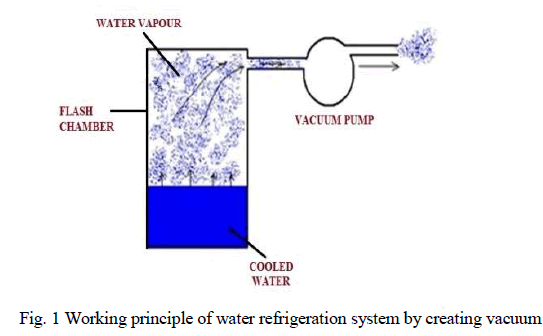 |
| WORKING: |
| The schematic representation of the water refrigeration system by creating vacuum is shown in fig.2. The main working starts with filling the flash chamber with water up to a volume of 75% of the total volume. After the blower pipe is connected to the flash chamber inlet steel pipe, then the blower is started to run. Blower creates vacuum in the chamber by doing that the water boiling point reduces and water starts evaporated by taking latent heat from water itself. Evaporated water goes out in the form of water vapours. Then we achieve a temperature drop of the water in the flash chamber. The cooled water is released in to the storage tank by the operating tap, thus the total cooled water is removed from the flash chamber. From the storage tank the water is passed to the air cooler through a connecting pipe which gives cooled water on to the air cooler mesh the water is flowed through the mesh at the same time the cooler is ON by the working of the cooler it absorbs the cooling from the water and through the fan and it gives cooling effect to the surroundings which it was placed. The water which is passed through the mesh is stored in the air cooler itself which it is provided with a storage space. A pump is placed in the storage space, in order to pump the water to the flash chamber. Thus the used water can be used again by recirculating it to the flash chamber. |
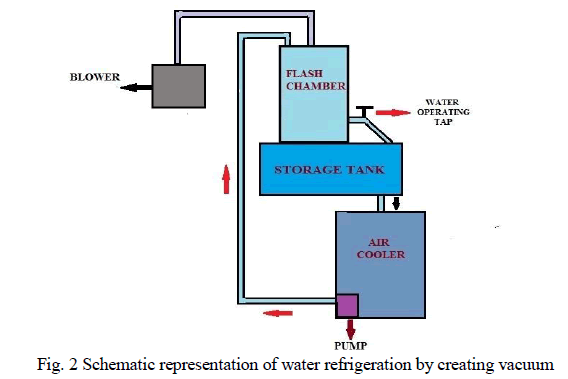 |
COMPONENTS REQUIRED |
| The following components are required for making the refrigeration system. |
| 1. Blower |
| 2. Flash chamber |
| 3. Storage tank |
| 4. Air cooler |
| Blower: This is the most basic and important component of this system. The vacuum created in the flash chamber is by means of this blower.A blower can be a vacuum pump, a vacuum cleaner or simply a blower. This blower is connected to the flash chamber for creating vacuum. This vacuum creates low pressures which lead to the drop in boiling point of the water. |
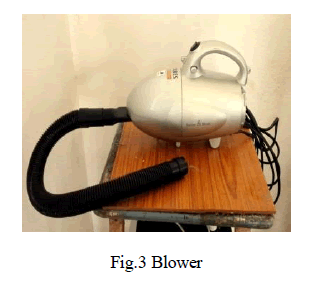 |
| Flash Chamber: Flash chamber is made up of stainless steel material. We made two holes in the upper portion of the chamber, one hole is welded with a steel pipe for the pupose of connecting the vacuum pump hose pipe and the other hole is made for fixing a plastic pipe which is the outlet of the air cooler. Another hole is made to the wall lower portion for fixing a operating tap, a plastic pipe is connected to the tap inorder to make a connection between flash chamber and the storage tank. It is highly insulated with the asbestos powder. Insulation is made in order to control the heat transfer to the surroundings. As we are producing cooling effect in the flash chamber the cooling effect sholud not be lost to the surroundings. |
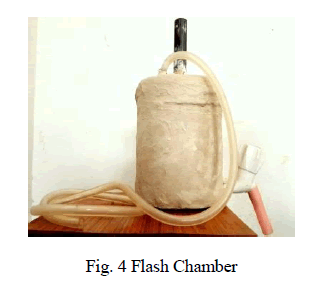 |
| Storage Tank:A thermocol box is used as a storage tank. The main purpose of using this tank is to have storage of cooled water which is produced in the flash chamber. Inlet of the flash chamber is connected to the outlet of the flash chamber. Also a hole is made in the bottom area of the storage tank which is connected with a plastic pipe, which is the inlet connection to the air cooler. |
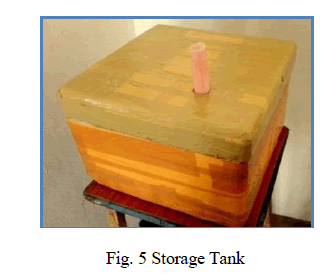 |
| Air Cooler: A potable air cooler is used in this experiment. The cooler consists of a mesh, a motor connected to an intake fan. Also there is a pump exist in the water storage area for re circulating the used water. The actual design is changed to the requirement of the experiment. The connecting pipe between the pump and mesh upper part is removed, a pipe is connected to the pump out let and flash chamber inlet, by doing that the used water is re circulated in to the flash chamber. |
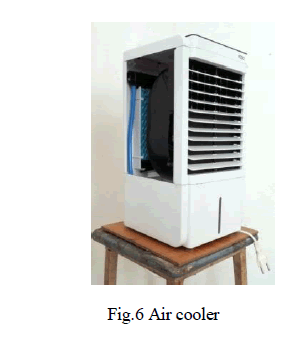 |
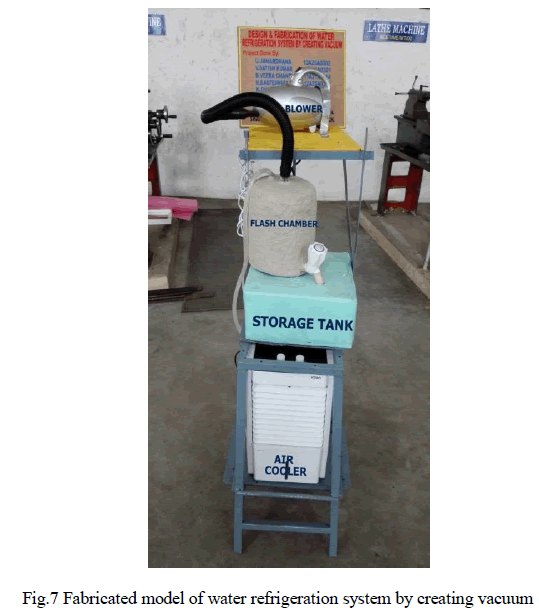 |
CALCULATIONS |
| Coefficient of performance: |
| C.O.P=Refrigeration Effect/Work Done |
| = h2 –h1/Work Supply |
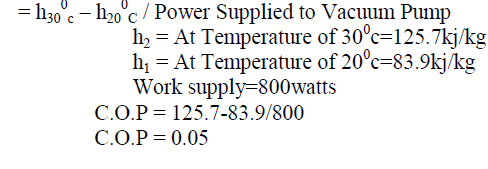 |
| Critical radius of insulation: |
| Thermal conductivity of plaster of Paris (K) = 0.17w/m.k |
| Critical radius (RC) = K/H0 |
| Where H0 = 20w/m2 (Assumed value) |
| K = 0.17w/m.k |
| = 0.17/20 |
| = 8.5X10-3 |
| RC ≈ 9 mm |
| Actual diameter (R1) = 165mm |
| Outer diameter (R2) = 176mm |
| Insulation diameter = 11mm |
| Critical radius of insulation |
| R2>RC |
| Therefore the sufficient insulation is provided to control the heat loss to the surroundings. |
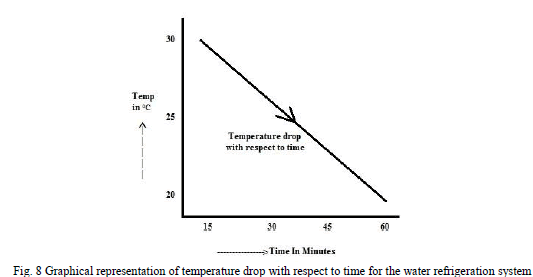 |
| Fig 8 represents the graphical view of the temperature drop with respect to the time. By this graph we can analyse the result that the temperature of the water reduces with respect to the running time of the blower. |
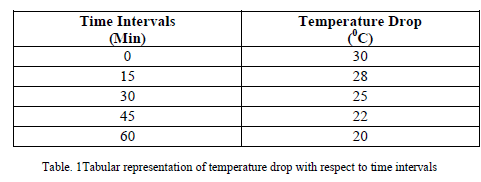 |
| The above table is drawn according to the readings obtained by running the experiment for 1 hour, the temperature is measured by using the thermometer. |
CONCLUSION |
| Refrigeration systems by creating vacuum have been fabricated. Various tests were conducted on the system and the results were obtained. With the results obtained we came to a conclusion that efficiency of the system will be high at a pressure drop of 0.023 bar gives a temperature drop up to 200C. The temperature of water is reduced about 100C. This project is not confined for application chosen, but this is an experiment which helps the atmosphere by eliminating the air pollution. It is purely Eco Friendly. |
References |
|